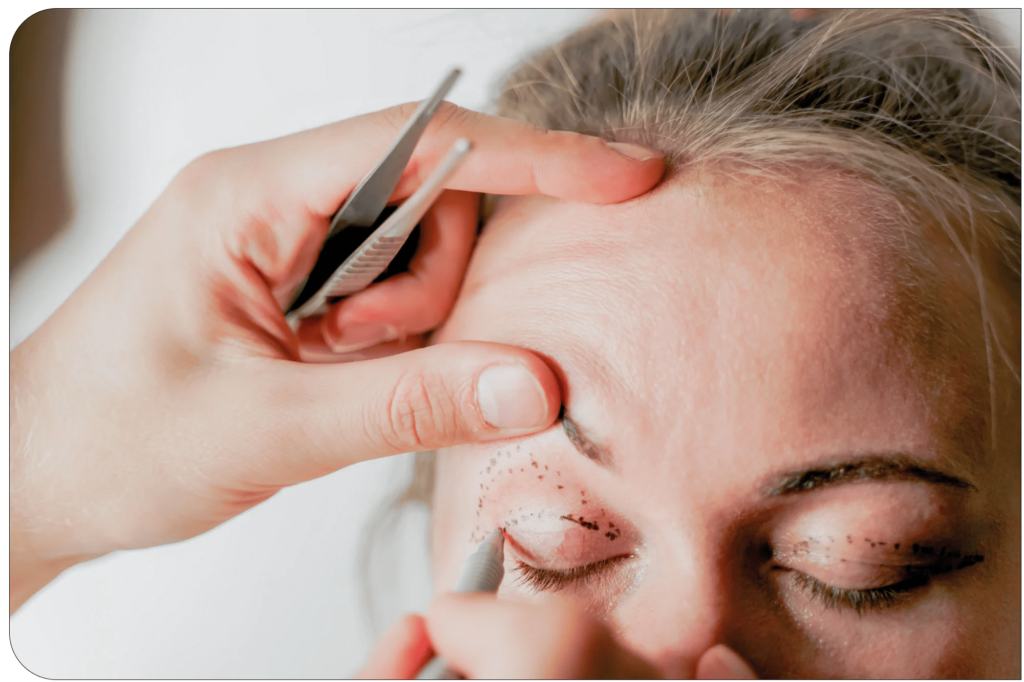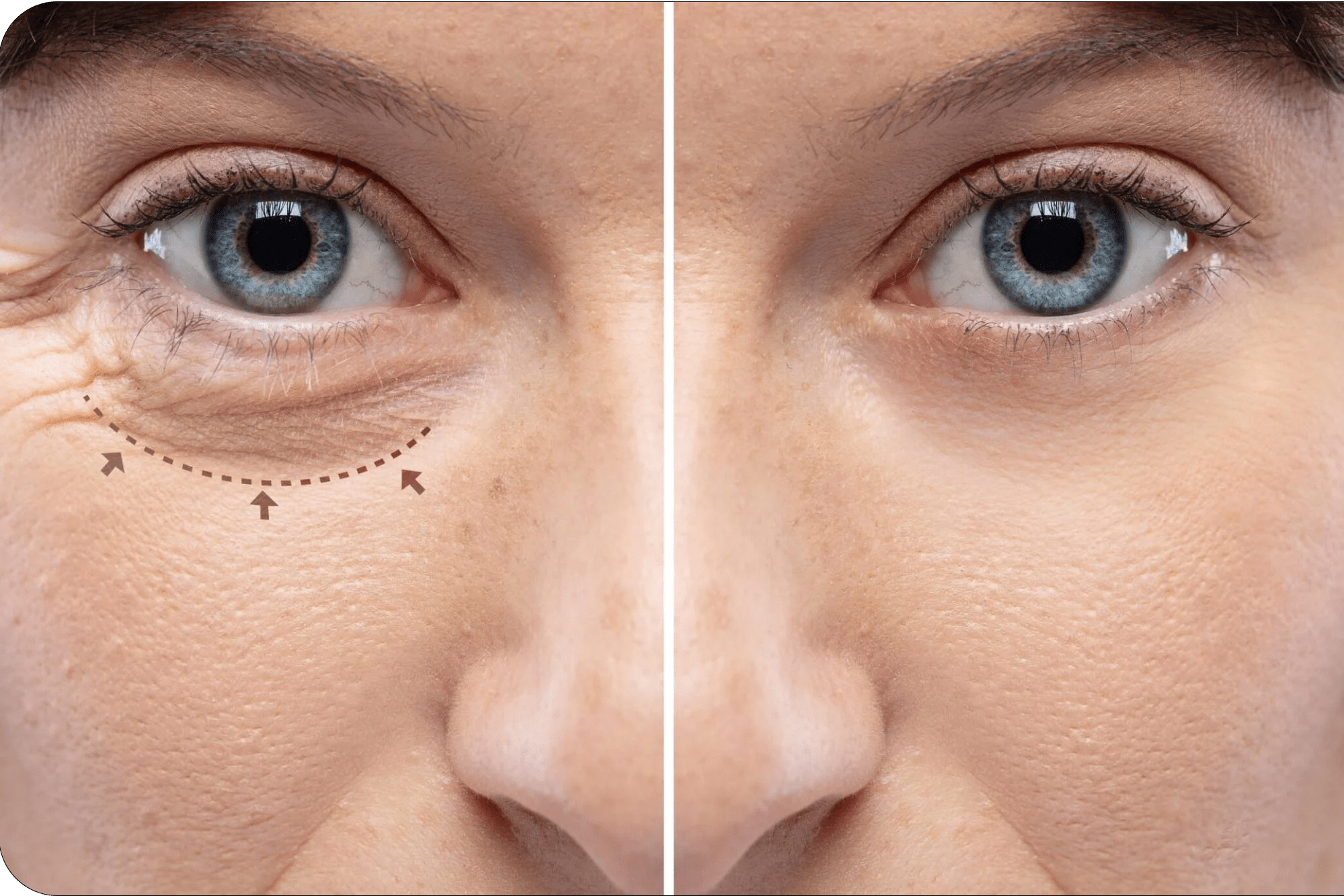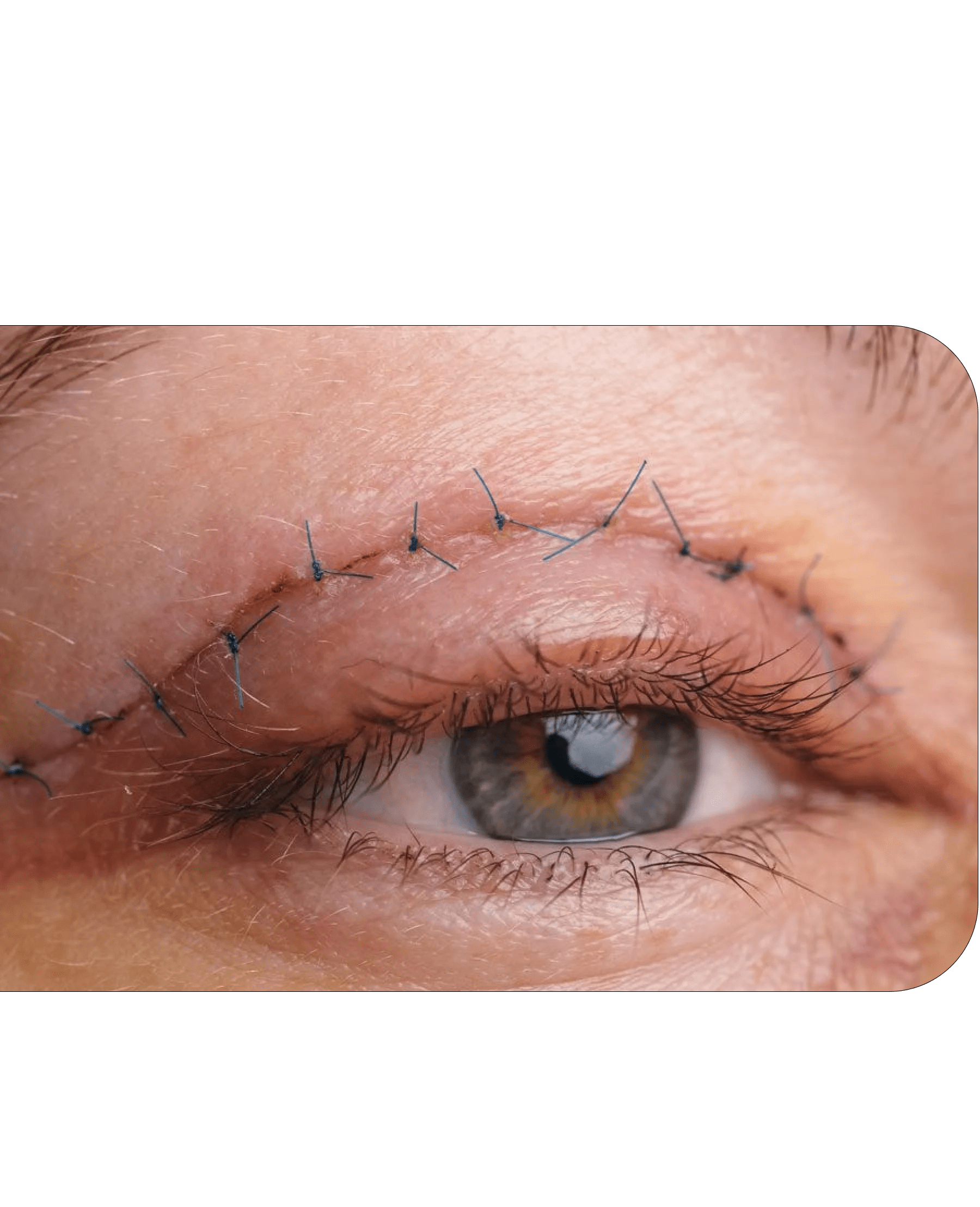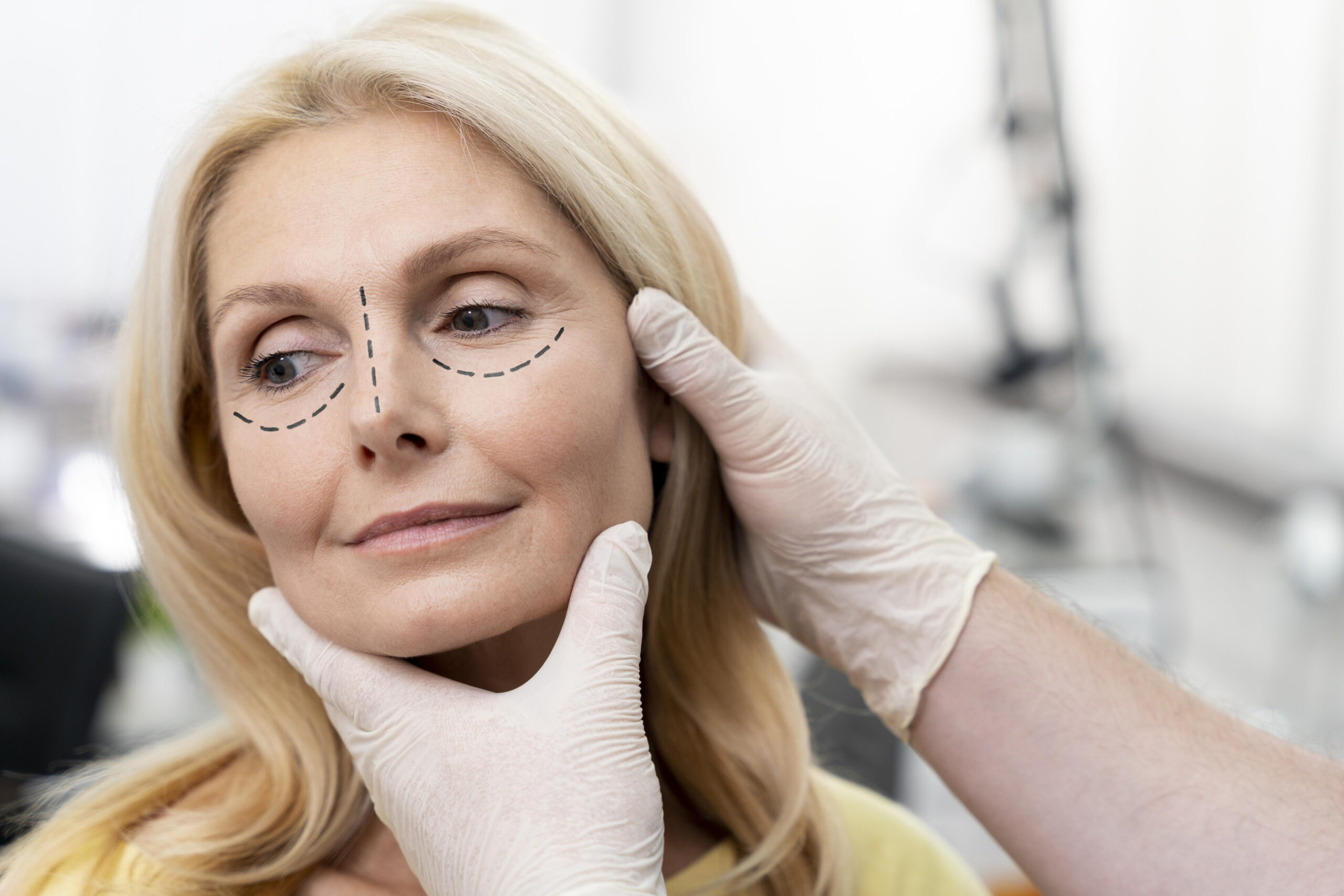
Eyelid Surgery:
Blepharoplasty
Blepharoplasty, commonly known as eyelid surgery, is a cosmetic surgical procedure that is performed to improve the appearance of the eyelids. It can be done on the upper eyelids, lower eyelids, or both. The primary goals of blepharoplasty are to remove excess skin, fat, and muscle from the eyelids, as well as to tighten and rejuvenate the area around the eyes.
Process of the blepharoplasty operation:
1. Consultation: The consultation with a board-certified oculoplastic surgeon is the first step in the procedure. The surgeon will review the patient's medical history, talk with them about their expectations and goals, and deeply examine their eyelids and surrounding tissues during this consultation. Additionally, they will evaluate the patient's general health to see if they are a good candidate for the treatment.

2. Incision placement: Based on the patient's specific needs and desired outcomes, the surgeon will carefully plan the incision placement. For upper eyelid surgery, allowing for the removal or repositioning of excess skin, muscle, and fat, the incision is typically made along the natural crease of the eyelid. For lower eyelid surgery, the incision may be inside the lower eyelid (transconjunctival approach) to access the fat pads or may be made just below the lash line.
3. Tightening and Tissue removal: The surgeon will proceed with removing extra skin, muscle, and fat after making the incisions as needed. They may use a combination of techniques, such as cutting, cauterization, or excision, to achieve the requested results. In some cases, to correct hollowness or contour irregularities fat grafting or repositioning may be performed.
4. Closure: The surgeon will meticulously close the incisions using sutures or tissue adhesive, after the necessary tissue adjustments have been made. To ensure, the incisions are carefully aligned, to promote optimal healing and minimal scarring.
5. Recovery and post-operative care: Following the procedure, the patient will be monitored before being allowed to return home on the same day. The surgeon will provide detailed instructions on post-operative care, including application of cold compresses, and avoidance of strenuous activities. During the initial recovery period which typically lasts for a few weeks swelling, bruising, and temporary discomfort are common.
6. Follow-up appointments: To monitor the healing process, remove sutures, and address any concerns or questions the patient may have, several follow-up appointments will schedule by the surgeon. Patient will be guided the gradual resumption of regular activities, the use of sunscreen or sunglasses to protect the delicate skin around the eyes and on proper wound care.
Upper Blepharoplasty is a surgical procedure that focuses on rejuvenating the appearance of upper eyelids by removing excess skin, muscle, and repositioning the fats on upper eyelids. Here's a step-by-step explanation of how upper blepharoplasty is typically done:
1. Anesthesia: The procedure, depending on the surgeon's recommendation and the patient's preference, begins with the administration of local anesthesia with sedation or general anesthesia. Throughout the surgery, this ensures that the patient remains comfortable and painless.

2. Incision placement: The incision placement will be carefully planned by the surgeon along the natural crease of the upper eyelid. This placement allows for the incision to be well-hidden within the natural folds of the eyelid. Depending on the extent of correction needed, the length of the incision may change.
3. Tissue removal: The surgeon proceeds to remove the excess skin, muscle, and fat from the upper eyelids, once the incisions are made. The desired amount of tissue will be removed with different techniques such as excision, cutting, or cauterization to precisely. Resulting in a more youthful and viddy appearance, removing excess skin eliminates sagging.
4. Muscle and fat adjustment: In some cases, the surgeon may also address the fat pads underlying muscle during the procedure. The levator muscle, which is responsible for eyelid movement, can be tightened or repositioned to improve eyelid function and enhance the eyelid's contour. Additionally, to achieve a smoother, more rejuvenated eyelid appearance fat pads may be repositioned or removed.
5. Closure: The surgeon carefully closes the incisions using sutures or tissue adhesive, after the necessary tissue adjustments have been made. To ensure proper alignment and minimize scarring, the sutures are meticulously placed.
6. Recovery and post-operative care: Following the surgery, the patient is before being discharged on the same day, usually observed in the hospital. The surgeon will provide detailed instructions on post-operative care, including application of cold compresses, and avoidance of strenuous activities. During the initial recovery period which typically lasts for a few weeks swelling, bruising, and temporary discomfort are common.
7. Healing and results: Patients may experience temporary swelling, bruising, and mild discomfort, in the initial recovery period. However, over the course of a few weeks these side effects gradually subside. Final result of the procedure become more apparent as the healing process progresses and the incision scars typically fade and become less noticeable with time. The patient will usually have follow-up appointments with the surgeon to monitor the healing progress and address any concerns or questions. They will provide guidance the gradual resumption of regular activities, the use of sunscreen or sunglasses to protect the delicate skin around the eyes and on proper wound care.

Lower Blepharoplasty is a surgical procedure that focuses on rejuvenating the appearance of the lower eyelids by addressing concerns such as excess skin, muscle laxity, and fat deposits. Here is a step-by-step explanation of how lower blepharoplasty is typically performed:
1. Anesthesia: Depending on the surgeon's recommendation and the patient's preference, the procedure will be done under sedation or general anesthesia. Commonly general anesthesia is preferred in lower eyelid blepharoplasty due to requering more detailed work.
2. Incision placement: Based on the specific needs of the patient, the surgeon plans the incision placement.
For lower blepharoplasty, there are two common approaches:
a. External incision: Extending horizontally along the lower eyelid, the incision is made just below the lash line. This approach allows the surgeon to remove excess skin, tighten the underlying muscle, and address fat deposits if it is needed.
b. Transconjunctival incision: In some cases, the incision may be made inside the lower eyelid. When excess fat is the primary concern, and it allows the surgeon to access and remove or reposition the fat without any external incision or visible scarring, this approach is suitable.
3. Removing excess skin: The surgeon proceeds to remove the excess skin, muscle, and fat from the lower eyelids, once the incisions are made. The desired amount of tissue will be removed with different techniques such as excision, cutting, or cauterization precisely. If there are fat deposits, they will be carefully redistributed or removed to improve the contour of the lower eyelids.
4. Muscle tightening: The surgeon may perform a muscle tightening procedure known as a canthopexy or canthoplasty, If the underlying muscle (orbicularis oculi muscle) is lax or contributing to the appearance of bags under the eyes. This technique involves securing the lateral canthal tendon to improve the overall support and shape of the lower eyelid, repositioning and securing.
5. Closure: The surgeon meticulously closes the incisions using sutures or tissue adhesive, once the necessary tissue adjustments have been made. To ensure proper alignment and promote optimal healing, the sutures are placed carefully. In the case of a transconjunctival incision, no external sutures are needed as the incision is inside the eyelid.
6. Recovery and post-operative care: Following the surgery, the patient is before being discharged on the same day, usually observed in the hospital. The surgeon will provide detailed instructions on post-operative care, including application of cold compresses, and avoidance of strenuous activities. During the initial recovery period which typically lasts for a few weeks swelling, bruising, and temporary discomfort are common.
7. Healing and results: During the initial recovery period, swelling, bruising, and mild discomfort are common. over the course of a few weeks, these side effects decrease gradually. With time, the incision scars typically fade and become less noticeable. The final result of the procedure, become more apparent as the healing process progresses. Follow-up appointments with the surgeon will be scheduled to monitor the healing progress and address any concerns or questions.

Benefits of Blepharoplasty:
Rejuvenated Appearance: Blepharoplasty helps patients look more youthful, alert, and refreshed. It can significantly improve the appearance of your eyes.
Enhanced Confidence: Blepharoplasty boosts self-esteem and confidence of patients by addressing cosmetic concerns such as sagging eyelids and under-eye bags.
Improved Vision: Sagging upper eyelids can obstruct your vision, in some cases. Blepharoplasty can help leading to clearer and more comfortable eyesight.

Recovery Period after Blepharoplasty:
Whether upper or lower, the recovery period after blepharoplasty, involves several stages as the body heals from the surgical procedure. Here is a general overview of how the recovery process typically proceeds:
Immediate Post-Operative Period: The patient is usually monitored in a recovery area for a few hours after the blepharoplasty surgery. To protect the incisions and promote healing, the surgical site may be covered with ointment and/or sterile dressings. Common and expected during this initial stage the patient may experience some mild discomfort, swelling, and blurred vision.
First Few Days: For initial healing the first few days after blepharoplasty are crucial. The patient should follow the specific post-operative care instructions provided by the surgeon, which may include:
To the surgical area to reduce swelling and bruising, applying cold compresses or ice packs.
As directed by the surgeon, taking prescribed pain medication and/or over-the-counter pain relievers.
To prevent infection, using prescribed antibiotic ointment or eye drops.
During sleep and rest to minimize swelling, keeping the head elevated.
Swelling and Bruising: Within the first few days, swelling and bruising around the eyes are common after blepharoplasty and gradually peak. Within 1-2 weeks, they will then begin to subside, with most visible bruising resolving. For several weeks, swelling may persist but will progressively decrease over time.
Sutures and dressing removal: Sutures are typically removed within 5-7 days after the procedure, if non-absorbable sutures were used during the surgery. The surgeon will assess the incision sites and determine the appropriate time for suture removal. During this time, dressings or sterile strips applied to the incisions may also be removed.
Resuming normal activities: The timeline for resuming normal activities varies depending on the individual and the extent of the surgery. However, most patients can expect to:
Depending on the nature of their job and the rate of recovery, they return to work within 1-2 weeks,
Over time gradually increasing intensity, resume light activities and exercise after a couple of weeks,
To promote proper healing, avoid strenuous activities, heavy lifting, and bending for several weeks to prevent complications.
Long-term recovery and final results: As the healing progresses, the final results of blepharoplasty become more apparent. The incision scars should gradually fade and flatten over the course of several months but it might will initially be pink or slightly raised. Use sunscreen when exposed to the sun to minimize scar discoloration, it is essential to protect the incisions from direct sunlight.
It's important to note that recovery timelines and individual experiences may vary. It's crucial to attend follow-up appointments, and communicate any concerns or unusual symptoms with your healthcare provider, follow the specific post-operative care instructions provided by your surgeon. You can ensure a smooth recovery and achieve the best possible long-term results, by doing so.
At Elan Tour On Time, we understand the importance of providing exceptional care and support to our clients throughout their medical travel journey. When you choose us for your Blepharoplasty procedure, you can expect:
Access to renowned and experienced surgeons who specialize in cosmetic and functional eyelid surgery.
State-of-the-art medical facilities equipped with advanced technology.
Personalized assistance with travel arrangements, accommodation, and post-operative care. Affordable and transparent pricing options.
A dedicated team committed to ensuring your comfort, safety, and satisfaction.
Take the first step towards youthful and vibrant eyes with Blepharoplasty at Elan Tour On Time.
Contact us today to schedule a consultation and embark on your journey to a more confident and refreshed appearance.
Frequently Asked Questions



